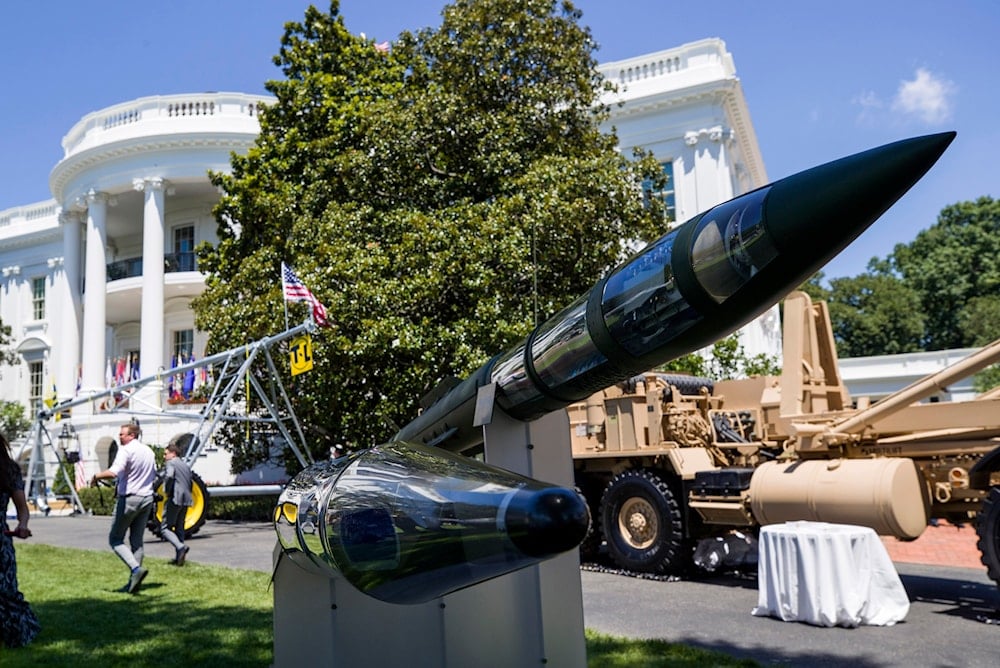US air defense drain alarms Pentagon leaders: Israel media
The US has depleted a quarter of its THAAD interceptors defending "Israel" from Iran, raising concerns over missile defense shortages and military readiness.
-

A Terminal High Altitude Area Defense (THAAD) anti-ballistic missile defense system is displayed during a Made in America showcase on the South Lawn of the White House, July 15, 2019, in Washington (AP)
The Israeli Defense magazine published a report on what it called "the erosion of the US defense systems in the Israel-Iran war," detailing the United States' heavy deployment of THAAD batteries across "Israel" to defend it during the 12-day war waged on Iran.
The report cited statistics from The War Zone, showing that the US military fired over 150 THAAD interceptors to counter salvos of ballistic missiles launched by Iran toward "Israel".
The report added that this number represents roughly a quarter of all interceptors the Pentagon has acquired since the system entered service, highlighting what Israel Defense called "the alarming depletion rate of US defensive arsenals in such a short timeframe."
The magazine's report also detailed the US Navy's involvement, noting that approximately 80 SM-3 missiles were fired from warships during the war, putting their real-world effectiveness into question. "Questions emerged about the missiles' real-world effectiveness, prompting the Pentagon to conduct an in-depth operational review of every launch," it added.
US puts itself in a risky situation for 'Israel'
The report emphasized that the consequences of this situation are not limited to the Middle East. Given the ongoing US support for Ukraine, which is consuming substantial resources, serious questions are being raised about America's preparedness for a potential future conflict with China in the Pacific. Such a confrontation could require significantly more intensive use of advanced interceptors, according to the analysis.
The report noted that the 2026 budget reveals replenishing the depleted stock of THAAD interceptors alone will take approximately four years, while pointing out that the actual production process for these missiles requires an even longer timeframe.
According to a CNN report published on July 28, the fast expenditure of THAAD interceptors in the defense of "Israel" has sparked worries about the United States' military readiness, as well as its capacity to replenish its stockpile of such critical defenses.
'Israel' depleted 25% of America's THAAD interceptor inventory
An unnamed retired senior US Army officer told CNN that US forces supporting Israeli operations deployed nearly 25 percent of America's THAAD interceptor inventory, prompting the Pentagon to urgently reevaluate its wartime munitions stockpiles and accelerate plans to significantly increase annual production capacity following years of insufficient preparedness.
Four former senior US defense officials revealed that concerns about America's interceptor inventories predated the recent 12-day war, specifically highlighting alarmingly low stockpiles of advanced missile defense systems that serve as crucial deterrents against a much-feared Chinese attack.
A defense official told CNN he was shocked by how low THAAD interceptor stocks had fallen, warning that Washington urgently needs more missiles and faster production, while another official stressed that US air defense inventories are critically insufficient for modern warfare demands.
Israeli Defense concluded by warning that this situation should serve as a clear wake-up call for Pentagon planners and US national security officials, emphasizing that maintaining advanced weapons stockpiles is not just a logistical concern but a fundamental component of military deterrence and international stability.

 3 Min Read
3 Min Read









